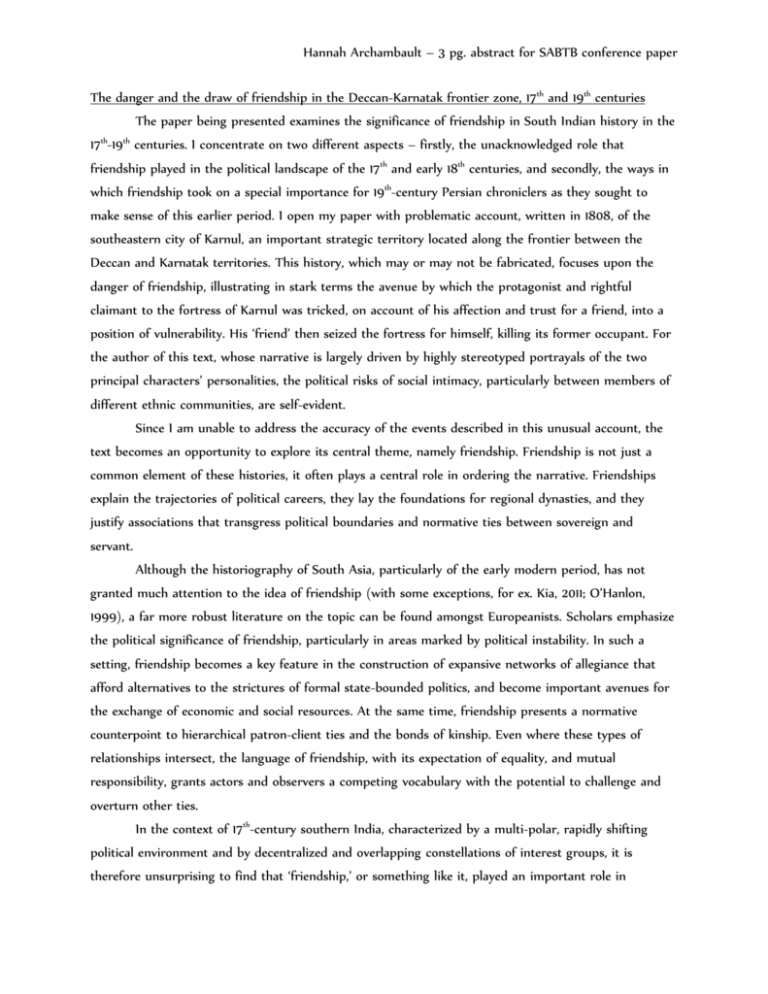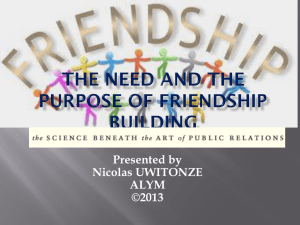Friendship as Origin Myth and as History in 17th
advertisement

Hannah Archambault – 3 pg. abstract for SABTB conference paper The danger and the draw of friendship in the Deccan-Karnatak frontier zone, 17th and 19th centuries The paper being presented examines the significance of friendship in South Indian history in the th th 17 -19 centuries. I concentrate on two different aspects – firstly, the unacknowledged role that friendship played in the political landscape of the 17th and early 18th centuries, and secondly, the ways in which friendship took on a special importance for 19th-century Persian chroniclers as they sought to make sense of this earlier period. I open my paper with problematic account, written in 1808, of the southeastern city of Karnul, an important strategic territory located along the frontier between the Deccan and Karnatak territories. This history, which may or may not be fabricated, focuses upon the danger of friendship, illustrating in stark terms the avenue by which the protagonist and rightful claimant to the fortress of Karnul was tricked, on account of his affection and trust for a friend, into a position of vulnerability. His ‘friend’ then seized the fortress for himself, killing its former occupant. For the author of this text, whose narrative is largely driven by highly stereotyped portrayals of the two principal characters’ personalities, the political risks of social intimacy, particularly between members of different ethnic communities, are self-evident. Since I am unable to address the accuracy of the events described in this unusual account, the text becomes an opportunity to explore its central theme, namely friendship. Friendship is not just a common element of these histories, it often plays a central role in ordering the narrative. Friendships explain the trajectories of political careers, they lay the foundations for regional dynasties, and they justify associations that transgress political boundaries and normative ties between sovereign and servant. Although the historiography of South Asia, particularly of the early modern period, has not granted much attention to the idea of friendship (with some exceptions, for ex. Kia, 2011; O’Hanlon, 1999), a far more robust literature on the topic can be found amongst Europeanists. Scholars emphasize the political significance of friendship, particularly in areas marked by political instability. In such a setting, friendship becomes a key feature in the construction of expansive networks of allegiance that afford alternatives to the strictures of formal state-bounded politics, and become important avenues for the exchange of economic and social resources. At the same time, friendship presents a normative counterpoint to hierarchical patron-client ties and the bonds of kinship. Even where these types of relationships intersect, the language of friendship, with its expectation of equality, and mutual responsibility, grants actors and observers a competing vocabulary with the potential to challenge and overturn other ties. In the context of 17th-century southern India, characterized by a multi-polar, rapidly shifting political environment and by decentralized and overlapping constellations of interest groups, it is therefore unsurprising to find that ‘friendship,’ or something like it, played an important role in Hannah Archambault – 3 pg. abstract for SABTB conference paper organizing the political landscape. Contemporary evidence points to these ties as anchoring mechanisms and as loci for the transfer of resources across geographically and politically dispersed networks. This, however, has not been adequately addressed within the literature, which has tended to concentrate instead upon ethnic conflict as a primary structuring element in the region (see scholarship on the Deccan Sultanates from Jadunath Sarkar in the early 20th C., to Kruijtzer, 2009). Later 19th-century accounts of the 17th century not only reflected these earlier relationships, but also turned to friendship as a means of making the past legible. In a setting where it was important for authors to distinguish rights from wrongs, shaping narratives that legitimized certain stakeholders while villainizing others, but where service to one’s sovereign, a tried-and-true measure of aristocratic legitimacy in other settings, seemed comparatively meaningless, friendship took on a particular value for its normative heft. The material I present here is, while an important element of my dissertation, not strictly derived from one chapter or another. Instead I am presenting this material as an experiment in reading these sources, clustered respectively in the 17th and 19th centuries. In its larger form, my project focuses on two closely affiliated Indo-Afghan lineages who settled in the southern Deccan region in the midseventeenth century, and traces their history up to the end of the 18th century. These lineages were members of a regional military nobility that served first the Adil Shahi Sultanate at Bijapur before shifting to Mughal service in the 1670s and 1680s, before establishing their own autonomous polities within the southern Deccan-northern Karnatak frontier regions after the decline of Mughal imperial power in the early 18th century. Based in the territories of Karnul, Kadapa and Savanur, they negotiated an evolving relationship with a series of regional and imperialist polities. While keeping the lens concentrated on these two families, my project explores three main themes. Firstly, I address the significance of the southern Deccan-northern Karnatak frontier zone where these groups settled. Locally rooted interest groups like the Pannis and Miyanas were able to leverage their close relationship to these regions against the centralizing impulse of larger neighboring powers. The region operated as a zone of multiple sovereignty across an era marked by the rise and fall of several regional polities; the success of noble lineages like these was closely tied to their ability to negotiate competing claims towards their own purposes. Secondly, I examine the idea of ‘clan’ or ‘family’ as a structuring concept within a multipolar political context. My material provides opportunity to examine the ways in which power was shared, and competed for, within and across lineage groups. Kinship ties allowed for the pursuit of ‘family’ interests across borders and distances, producing a political vehicle that drew upon state power, but was in crucial respects unbound by it. A large literature in early modern South Asian historiography has organized itself around the state, focusing particularly on its location within society. My project builds upon this by exploring the ways in which Hannah Archambault – 3 pg. abstract for SABTB conference paper aristocratic lineages interacted with state power. Finally, I explore the relationship between sovereignty and memory, examining the ways in which the families’ history and their relationship to neighboring polities and groups were recollected over time. By the turn of the 19th century, accounts of these families often underscored their northern origins and imagined their long-standing service to the Mughal emperor, despite a confirmed earlier record of ambiguous and even contentious relations with Mughal power. The category of Afghan itself underwent substantial transformation in this period. While the earliest sources from the period seem to have found nothing surprising about the presence of a large and well-rooted Afghan community in southern India, their origins increasingly demanded explanation in later texts.






